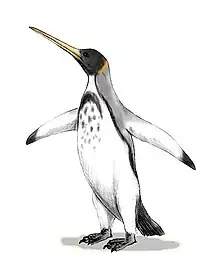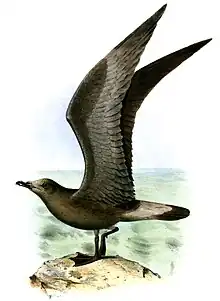| Kumimanu Temporal range: Paleocene, | |
|---|---|
 | |
| Life restoration of Kumimanu biceae | |
| Scientific classification | |
| Domain: | Eukaryota |
| Kingdom: | Animalia |
| Phylum: | Chordata |
| Class: | Aves |
| Order: | Sphenisciformes Mayr, Scofield, De Pietri & Tennyson, 2017 |
| Genus: | †Kumimanu |
| Type species | |
| † Kumimanu biceae Mayr, Scofield, De Pietri & Tennyson, 2017 | |
| Species | |
| |
Kumimanu is an extinct genus of giant penguin, which lived around 60 to 56 million years ago. The type species is K. biceae, which arose after the extinction of the non-avian dinosaurs.[1] Fossils were found in New Zealand, and the discovery was announced in December 2017.[1] A second species, Kumimanu fordycei, was named in February 2023.[2]
General information
The order Sphenisciformes refers to all living and extinct penguin species. In 2017 an article on one of the largest and oldest species of the order herewith discovered was published. It was discovered at Hampden Beach in the Otago region of New Zealand. This organism is named Kumimanu biceae, of which the genus name translates from Māori as "monster bird", while the specific name honours the nickname of the mother one of the authors. Total length from tip of the beak and tail is approximately five feet and three to ten inches (1.60 to 1.77 meters), and weighing over two hundred pounds (91 kg), being thus the second largest penguin thus far known. This is a particularly significant discovery because the fossil is fifty-five million years old — meaning it lived in the Paleocene era — which is many million years older than all other previously found remains of penguins which reached 'giant' sizes, and thus the third or fourth oldest penguin known (pending new publications). Therefore, it allows scientists to better understand the evolution of penguins.[1]
Kumimanu fordycei is the largest known living or extinct penguin species, with an estimated weight of 148 to 159.7 kg.[2] Some articles mention a height of about 5.2 ft (1.6 m),[3] although the paper refrains from estimating height or body length because stem and crown penguins have different proportions, and nearly complete skeletons are absent.[2] The species name honours palaeontologist Ewan Fordyce.[4]
Discovery and analysis
The fossils were found by a group of researchers from New Zealand in Otago, on the South Island of New Zealand. The fossils are from the Paleocene Waipara Greensand formation. The fossils were studied by a New Zealand and German team, led by Gerald Mayr of the Senckenberg Research Institute and Natural History Museum. He was the lead author of an article on the subject published online in December 2017.[1]
Kumimanu fordycei is named from a large specimen from the late Palaeocene Moeraki Formation, dating to 55.5-59.5 million years ago.[2] It was found by palaeontologist Alan Tennyson in 2017.[5]
Ecology and behavior
Kumimanu biceae lived in New Zealand, which was subtropical during much of the Paleocene era. There were many organisms in these waters including sea turtles and various fishes. K. biceae were likely similar to modern-day penguins in the way they lived. However, these “monster birds” were likely able to consume larger prey due to their size.
See also
References
- 1 2 3 4 Mayr, Gerald; Scofield, R. Paul; De Pietri, Vanesa L.; Tennyson, Alan J. D. (12 December 2017). "A Paleocene penguin from New Zealand substantiates multiple origins of gigantism in fossil Sphenisciformes". Nature Communications. 8 (1): 1927. doi:10.1038/s41467-017-01959-6. PMC 5727159. PMID 29233963.
- 1 2 3 4 Ksepka, Daniel T.; Field, Daniel J.; Heath, Tracy A.; Pett, Walker; Thomas, Daniel B.; Giovanardi, Simone; Tennyson, Alan J. D. (8 February 2023). "Largest-known fossil penguin provides insight into the early evolution of sphenisciform body size and flipper anatomy". Journal of Paleontology: 1–20. doi:10.1017/jpa.2022.88. ISSN 0022-3360. S2CID 256709376.
- ↑ Tamisiea, Jack (2023-02-08). "The Biggest Penguin That Ever Existed Was a 'Monster Bird'". The New York Times. ISSN 0362-4331. Retrieved 2023-02-09.
- ↑ Publisher, LiveNews. "Paleontology powerhouse honoured by former students | LiveNews.co.nz". Live News. Retrieved 9 February 2023.
- ↑ Tamisiea, Jack (8 February 2023). "The Biggest Penguin That Ever Existed Was a 'Monster Bird'". The New York Times. Retrieved 9 February 2023.
- Jadwiszczak, Piotr, et al. “Redescription Of Crossvallia Unienwillia: The Only Paleocene Antarctic Penguin.” Ameghiniana, vol. 50, no. 6, 2013, pp. 545–553., doi:10.5710/amgh.09.10.2013.1058"
- "Ancient Mega-Penguin Reached Human Height"
- Malcolm Ritter: "Ancient penguin was as big as a (human) Pittsburgh Penguin", retrieved 15 December 2017. (Note: The title refers to the Pittsburgh Penguins ice hockey team).

